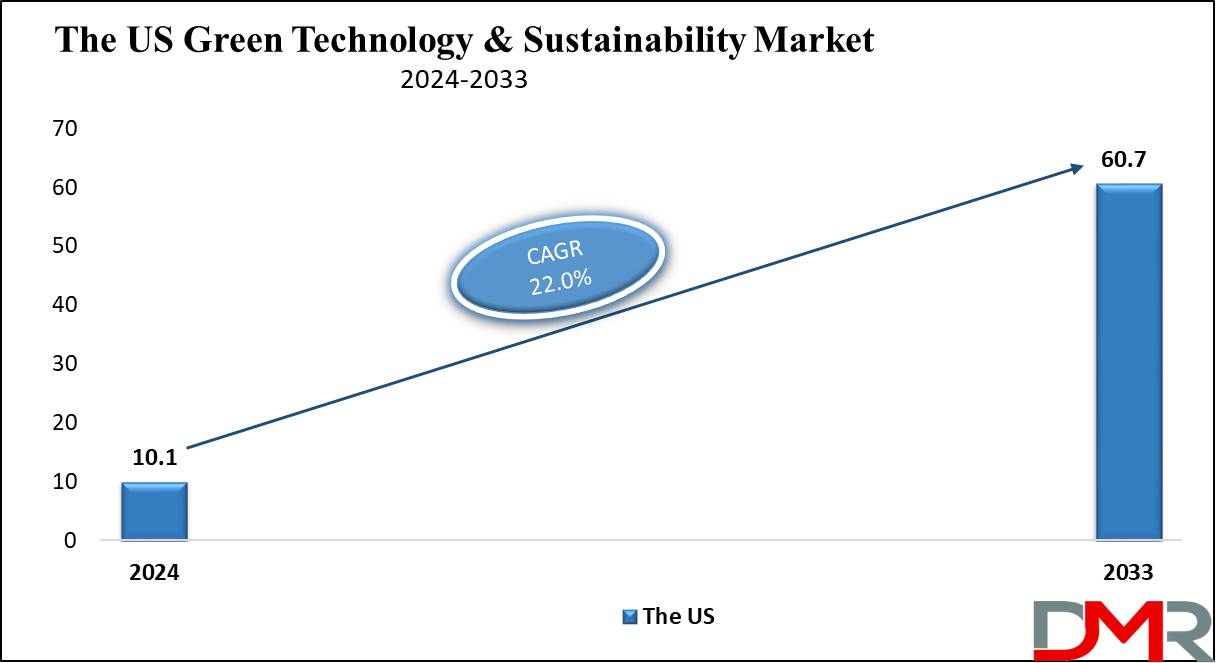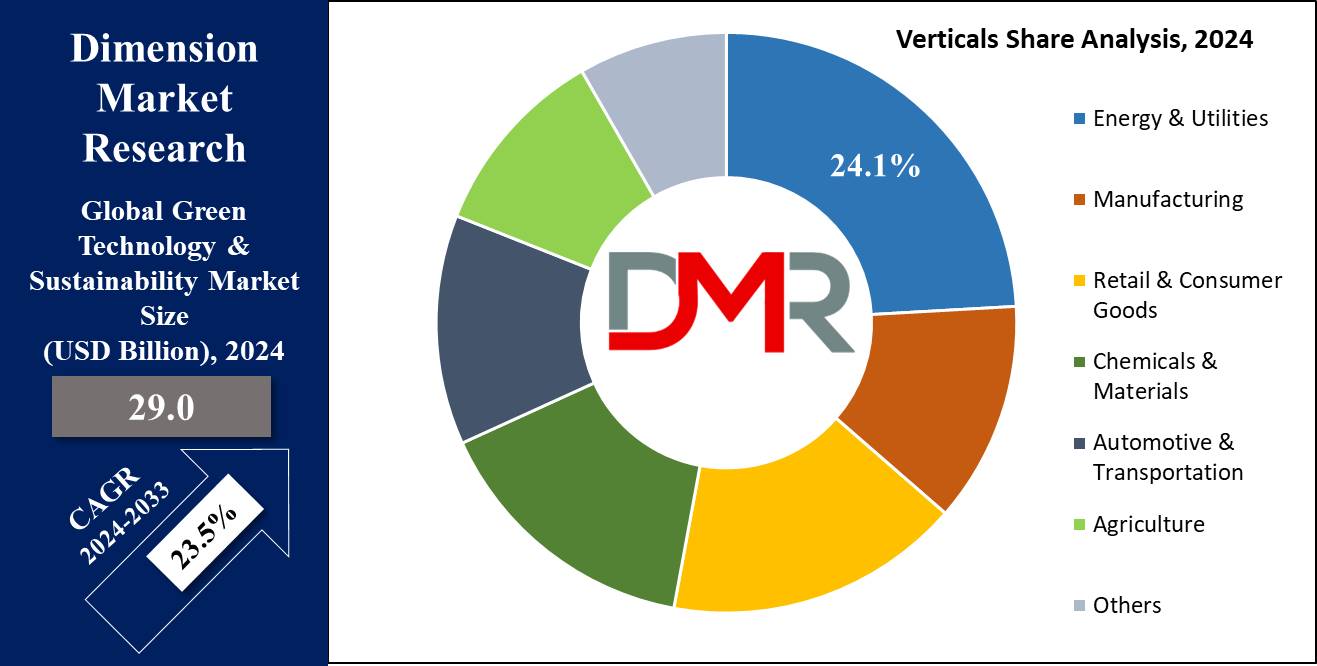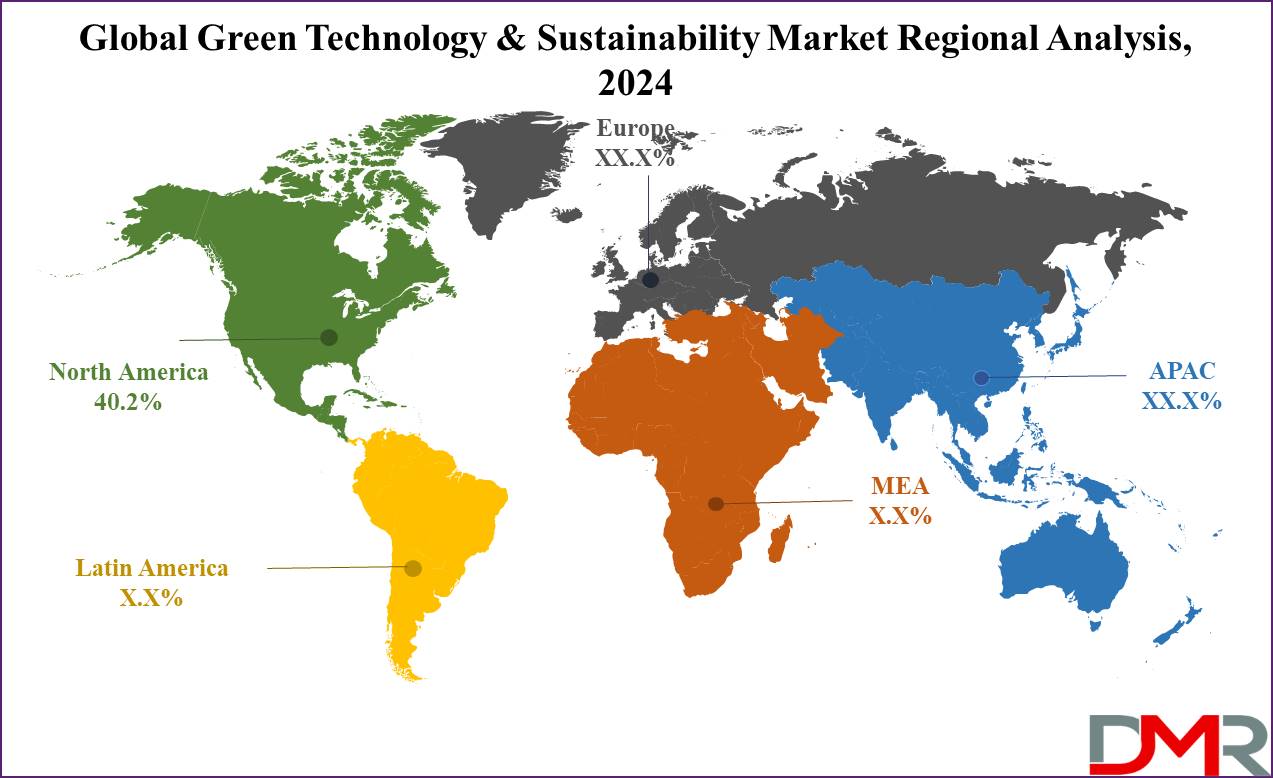Green technology and sustainability refer to innovations and practices to minimize their environmental impacts, conserve natural resources, and support long-term ecological equilibrium.
Eco-friendly technologies such as renewable energies such as solar and wind power generation, sustainable agriculture practices, waste management systems, and water conservation solutions should be employed for effective ecosystem preservation. The rapid expansion of the renewable energy solutions segment is a major contributor to the overall growth of the eco-innovation industry.
Green technology & sustainability market growth is being propelled by increasing environmental consciousness among both individuals and organizations alike, along with their awareness about climate change issues. Green technology utilizes renewable energy sources such as solar panels, LED lighting, wind power, vertical farming systems,
electric vehicles, and composting to protect the environment. This trend is further strengthening the global clean technology sector, integrating sustainability into mainstream industry practices.
Many countries around the world are now adopting green technologies for recycling and managing industrial and household waste, lowering emissions, conserving water usage, and reducing waste while using less energy compared to conventional methods, thus leading to their widespread global adoption. These advantages have greatly contributed to its global acceptance.
As per scaleflex Green Tech aims to mitigate the environmental impact of human activity by utilizing sustainable energy sources and eco-friendly technologies. This rapidly growing market has gained significant investor attention due to the rising awareness of climate change. In 2021, investments in technologies to reduce carbon emissions reached $755 billion, marking a 25% increase from the previous year.
Consumers are increasingly conscious of environmental issues and willing to support companies prioritizing sustainability. A significant 66% of global consumers are open to paying more for eco-friendly products. Major companies, like Microsoft, Google, and Apple, are committing to carbon neutrality by 2030, aligning their business strategies with environmental goals.
Mobility and transport sectors have attracted the most funding, with USD 58 billion invested in this area. The US leads in Green Tech investment, contributing USD 56 billion, while Europe and China follow behind. However, there is still a gap in funding for emission-reduction technologies.
The US Green Technology & Sustainability Market
The
US Green Technology & Sustainability Market is projected to reach
USD 10.1 billion by the end of 2024 and grow substantially to an expected
USD 60.7 billion market by 2033 at an anticipated
CAGR of 22.0 percent.

The U.S. green technology and sustainability market is driven by the growing regulatory push toward reducing carbon emissions and promoting sustainable practices. Additionally, rising awareness among the public regarding climate change, resource depletion, and environmental degradation has heightened the demand for sustainable solutions.
Increasing adoption of renewable energy technologies, especially solar and wind power, which continue to grow as costs decline, is one of the key trends in this market. The electric vehicle (EV) sector in this region is booming, with heightened consumer interest and substantial government support through tax credits and infrastructure investments, reflecting the continuous growth of the clean technology sector.
Key Takeaways
- Market Growth: The global green technology & sustainability market is projected to grow by USD 158.8 billion, with a CAGR of 23.5%.
- Market Definition: Green technology and sustainability refer to innovations, products, and practices designed to minimize environmental impact and promote the sustainable use of resources.
- Component Analysis: Solution segment is expected to account for the largest revenue share, at 69.5%, by 2024.
- Deployment Mode Analysis: Cloud-based deployment is forecasted to secure a significant portion of market revenue by the close of 2024.
- Technology Analysis: Internet of Things is projected to lead with the highest revenue share of 45.2% by 2024.
- Verticals Analysis: Energy & Utilities sector is predicted to dominate, accounting for 24.1% of market revenue by 2024.
- Regional Analysis: North America is expected to lead the global green technology & sustainability market with a market share of 40.2% by 2024.
Use Cases
- Renewable Energy Generation: Clean energy production using solar, wind, and hydroelectric technologies reduces our dependency on fossil fuels while simultaneously decreasing greenhouse gas emissions and providing greater energy independence.
- Smart Grids: Integrating digital technology into electricity distribution systems to enable real-time monitoring and management of energy flows has resulted in greater energy efficiency through optimized electricity usage and demand response strategies. This innovative method improves energy performance.
- Sustainable Agriculture: Sustainable agriculture includes various practices like precision farming, vertical farming, and organic farming that aim at creating more cost-efficient food production systems while protecting the environment.
- Green Building Technologies: Utilizing eco-friendly building techniques such as using energy efficient systems and smart designs in construction helps lower energy usage while improving indoor air quality and decreasing carbon footprint of structures.
Market Dynamic
Drivers
AI-Driven Recycling Technologies
Artificial intelligence has emerged as an instrumental force within green technology and sustainability markets, spurring resource efficiency while mitigating environmental impact. From robotic sorting systems and supply chain optimization solutions to real-time data analysis and dynamic decision-making capabilities that help streamline operations while decreasing carbon emissions;
AI technologies help organizations realize sustainability goals while simultaneously improving brand perception among eco-minded customers and giving companies an edge over competition in the market.
Technological Advancements in Circular Economy Models
Economy Models Artificial intelligence's capacity for optimizing processes and improving sustainability outcomes has fueled the creation of smart waste management systems, energy-saving practices, and advanced circular economy models - each contributing significantly to expanding green technology markets by shifting industries towards more eco-friendly practices that promote long-term sustainability across sectors. These innovations contribute significantly to green tech's expansion.
Restraints
High Initial Costs of Green Technologies
The high cost of implementing green technology across various applications is a key factor limiting the market's growth. In developing countries, the adoption of these technologies depends on the affordability of services and products. Green technologies often shift energy production away from cheaper sources to more expensive, heavily subsidized options like wind and solar, which is hindering the expansion of the global green technology and sustainability market.
Inadequate Infrastructure and Support Systems
Another key challenge to the widespread adoption of green technologies is the lack of adequate infrastructure. Successful deployment of green solutions requires a robust combination of technology readiness, skilled human resources, geographic suitability, and supportive infrastructure. In regions where these elements are lacking, businesses may face significant hurdles in implementing green technologies.
This infrastructure gap is likely to slow down market growth, as companies struggle to meet the necessary conditions for adopting sustainable practices.
Opportunities
Nanotechnology for Product Efficiency
Manufacturers in the green technology and sustainability market are leveraging nanotechnology to enhance product efficiency, minimizing waste in the production process. This presents a major opportunity for expanding eco-friendly manufacturing practices and driving further sustainability in the industry.
Enhanced Consumer Awareness and Demand
As awareness of environmental issues rises, consumers are increasingly seeking sustainable products and practices. This growing demand presents an opportunity for companies in the green technology and sustainability market to develop and market innovative solutions that align with eco-conscious consumer preferences, ultimately driving market growth.
Trends
Rising Adoption of Cloud Computing
The growing demand for cloud infrastructure is driven by its ability to address two key aspects of a sustainable IT strategy: resource optimization and energy efficiency. Virtualization plays a crucial role in cloud implementation, allowing a single physical server to run multiple systems, thereby improving resource efficiency. This is fueling the global adoption of cloud computing.
Increased Focus on Acquisitions and Innovation
Market players are increasingly focusing on gaining a competitive advantage through technological innovations, advancements, and acquisitions. This trend is expected to drive further growth in the global green technology and sustainability market.
Research Scope and Analysis
By Component
The solution segment is expected to dominate the green technology & sustainability market with over 69.5% of global revenue for component categories including solutions and services. Emerging technologies are providing new avenues for green technology and sustainable development that take into account social, economic, and environmental considerations. Consumer demand has created this surge of activity on behalf of environmental responsibility.
As well, government initiatives promoting green technologies play a pivotal role in driving segment expansion. Awareness of technology's detrimental effect on the environment has become one of the major drivers behind the widespread adoption of green tech and sustainability solutions across multiple sectors worldwide, fueling market expansion. Technology advancement and innovative solutions are driving demand for green technologies and sustainable products worldwide.
After solutions, services have gained prominence as an integral component of sustainable technology solutions and markets. Their role lies in assuring their successful deployment and ongoing maintenance - something many organizations that use sustainable technologies need assistance with for optimal performance. When adopting sustainable technologies, they require support services including consulting, integration, and ongoing maintenance to maximize performance.
By Deployment Mode
The cloud segment is expected to dominate green technology & sustainability with revenue share in 2024, due to its numerous sustainability advantages, such as promoting energy efficiency, reducing the need for physical hardware, and minimizing environmental impact. Cloud solutions allow organizations to optimize resource use, resulting in lower energy consumption and reduced carbon footprints.
Additionally, growing public awareness is driving the adoption of cloud-based green technology and sustainability solutions. Furthermore, many cloud services use renewable energy, contributing to a cleaner and more sustainable ecosystem. These factors are expected to keep the cloud segment dominant in the coming years. Although the on-premise segment is anticipated to grow steadily, its pace is slower than that of the cloud segment, as they are increasingly in demand because they help reduce environmental impacts & CO2 emissions.
This growth is due to its ability to offer greater control, security, & customization for organizations. Companies with specific regulatory requirements or sensitive data often prefer on-premise solutions, as they provide more direct management of their infrastructure.
By Technology
Internet of Things is set to dominate the green technology and sustainability market by garnering a 45.2% revenue share due to its real-time monitoring, data collection, and automation features that provide real-time asset utilization, optimization as well as reduced environmental impacts. IoT devices enable businesses to monitor energy use, water use, and emissions across industries in real time and implement more sustainable practices.
By supporting smart grids, precision agriculture systems, and intelligent waste management solutions, IoT enhances operational efficiency while decreasing wastefulness. IoT also supports predictive maintenance and helps reduce downtime, contributing further to environmental sustainability through optimized resource allocation. AI and
machine learning have an enormously profound effect on the green technology and sustainability markets by fueling innovation and increasing efficiency across numerous sectors.
AI improves energy management through optimizing power consumption, optimizing grid operations, and supporting better integration of renewable energies to increase overall efficiency. Machine Learning (ML) algorithms analyze large datasets to enhance predictive maintenance strategies which decrease downtime and resource waste for sustainable infrastructures.
By Verticals
Energy & Utilities is likely to be the market leader in the green technology and sustainability market in 2024 with a share of 24.1%. Because the sector plays a crucial part in addressing climate change and making the shift to more sustainable energy technologies. This industry is responsible for a large percentage of the worldwide emission of greenhouse gasses, and the switch to sources of energy such as solar, wind, or hydropower is vital in curtailing such activities.

Smart grids, energy storage systems, & AI-based energy management technologies are actively used in the industry for energy generation, transmission, and consumption efficiency improvement. Increasing carbon neutrality policies as well as demand for some reduction of carbon emissions by governments have also boosted green technology in the energy and utility sector.
These endeavors are essential in enhancing the sustainability of the transformation of the sector in the green technology and sustainability market. Moreover, pressures and policies from global warming regulation have increased the growth of sustainable technology investments in the energy and utilities sector.
AI and ML technologies assist in sifting through big data to enhance grid operations, forecast energy requirements, and maximize energy usage efficiency. After Energy & Utilities, manufacturing will likely lead the green technology and sustainability market in terms of market size.
It plays a significant role due to the widespread adoption of sustainable manufacturing practices and energy-saving processes while adopting advanced technologies like IoT/AI to decrease carbon footprints.
The Global Green Market Report is segmented based on the following
By Component
- Solution
- Services
- Professional Services
- Consulting
- Integration & Deployment
- Support & Maintenance
- Managed Services
By Deployment Mode
By Technology
- Internet Of Things
- AI & ML
- Digital Twins
- Cloud Computing
- Blockchain
- Edge Computing
- Cybersecurity
By Verticals
- Retail & Consumer Goods
- Automotive & Transportation
- Energy & Utilities
- Chemicals & Materials
- Manufacturing
- Agriculture
- Others
Regional Analysis
North America is expected to dominate the global green technology & sustainability market with a revenue
share of 40.2% in 2024. The presence of numerous market players in the region significantly contributes to market growth. These key players are heavily investing in R&D to advance green technologies and adopting innovative solutions to reduce carbon and greenhouse gas emissions.

North American Climate, Energy, and Environment Partnership has motivated governments to adopt sustainable policies and prioritize renewable energy and electric vehicle purchases. Additionally, in collaboration with the International Renewable Energy Agency, the U.S., Canada, and Mexico launched a Trilateral North American initiative to support isolated, remote, and indigenous communities in transitioning to renewable and reliable energy sources.
The rise in global warming and pollution is driving demand for green technologies in this region as their abundant renewable resources, such as solar and wind energy, further fuel opportunities for green energy projects.
Asia Pacific region is also projected to become an appealing investment market with substantial CAGR growth during the forecast period. This is driven by rapid development in countries like India and China, with India emphasizing new technology integration to enhance business operations.
By Region
North America
Europe
- Germany
- The U.K.
- France
- Italy
- Russia
- Spain
- Benelux
- Nordic
- Rest of Europe
Asia-Pacific
- China
- Japan
- South Korea
- India
- ANZ
- ASEAN
- Rest of Asia-Pacific
Latin America
- Brazil
- Mexico
- Argentina
- Colombia
- Rest of Latin America
Middle East & Africa
- Saudi Arabia
- UAE
- South Africa
- Israel
- Egypt
- Rest of MEA
Competitive Landscape
The green technology and sustainability market is highly competitive, with numerous prominent and smaller players offering innovative solutions across both domestic and international markets. The market is currently moderately fragmented and is expected to move toward greater fragmentation. Key players in this market include companies focusing on development, innovations, and strategic acquisitions.
Major organizations such as General Electric, Salesforce, Inc., and Microsoft are adopting strategies like forming collaborations and partnerships, investing in new technologies, and extending their client base to enhance their competitiveness and expand their product offerings. Smaller businesses and startups are also securing funding to introduce advanced solutions and scale globally.
Some of the prominent players in the global green technology & sustainability market are
- General Electric
- Wolters Kluwer N.V.
- Salesforce, Inc.
- Microsoft
- Schneider Electric
- Engie Impact
- Cority (Enviance)
- Sensus, a Xylem brand
- LO3 Energy
- CropX, Inc.
- Others
Recent Development
- In March 2024, Schneider Electric highlighted the inclusion of innovative sustainable reporting to their EcoStruxure IT data center. The objective of the solution is to help data center operators meet the requirements of the European Efficiency Directive.
- In February 2024, IBM Envizi upgraded their Scope 3 emissions accounting solutions with more functions. This segment of IBM Envizi Suite, Supply Chain Intelligence module gathers product carbon footprint data.
- In February 2024, Microsoft launched their AI and data tools to help companies improve their sustainability objectives.
- In March 2024, The European Parliament made significant enhancements to the building energy operation rules to achieve a climate-neutral building sector by the end of 2050. Following this, the REPowerEU project intends to introduce 10 million heat pumps by the end of the same year.
- In February 2024, The U.S. Department of Energy announced over USD 366 million for 17 ventures across 30 Tribal States and societies across 20 states. These investments align with President Biden’s agenda to propel clean energy deployment in rural and remote areas across the country.
- In May 2023, SAP, a global software company based in Germany, launched its 'GreenToken' technology for energy companies in India. GreenToken is a SaaS-based solution designed for industries dealing with bulk-traded raw materials. The technology focuses on critical aspects such as carbon footprint, certified sustainability, zero child labor, and fair-trade labor practices.
- In May 2022, MetaVerse Green Exchange partnered with Red Dot Analytics to launch carbon-neutral data center operations, powered by blockchain and AI.